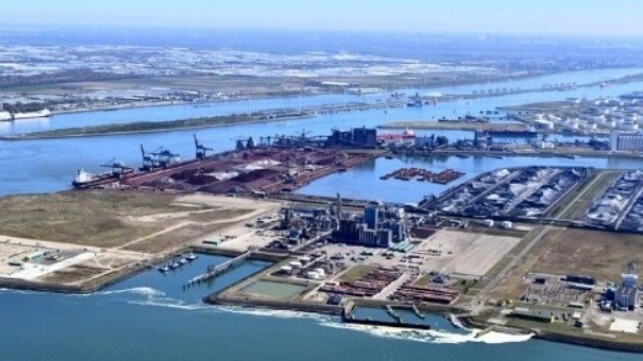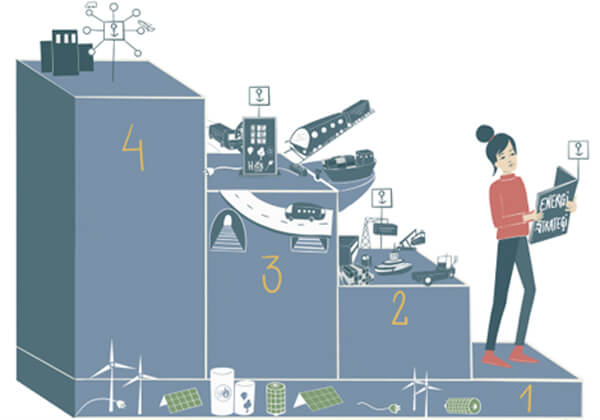The Role of Ports in the Energy Transition

by Mikael Lind, Sandra Haraldson, Wolfgang Lehmacher, Zeeshan Raza, Ellinor Forsström, Linda Astner, Jeremy Bentham, Xiuju Fu, Jimmy Suroto, Phanthian Zuesongdham
Introduction
A port is a transport, digital and energy node. On average 40% of goods going through ports are energy related. Ports are central nodes for sector coupling and energy system integration as they host and serve multiple industries including energy, shipping, trucking, railways, cruise-tourism, and manufacturing.
Decarbonization of transport requires collaboration across cargo owners, freight forwarders, ports, carriers, vehicle and engine manufacturers, energy producers, policy makers etc. Ports can capture the opportunity and play an important model role at the intersection of marine fuel, shipbuilding (including ship supplies), and operational value chains providing enablers of transport decarbonization.
This contribution, based on a larger Swedish study provides a framework (Figure 1) for guiding ports on building energy node capabilities. This framework's foundation is a port’s energy strategy (Level 1) factoring in, a port’s own energy needs (Level 2), green energy to port visitors (Level 3), and its role as part of the transport and energy ecosystem (Level 4).

Figure 1: Maturity framework for the port as energy node (Illustration: Sandra Haraldson)
The role of ports in decarbonization
The ports of Antwerp-Bruges, Hamburg, Rotterdam, and Singapore aim to position themselves as multi-fuel bunkering hubs. The signing of the Memorandum of Understanding (MOU) for the Singapore – Rotterdam Green Corridor in Singapore on 2 August 2022 is indicative of the trend.
As landlord and investor, ports can optimize spatial planning (as e.g. in Hamburg and Antwerp-Bruges) to ensure that land and infrastructure are available to facilitate low/no carbon energy projects, while (co-)investing in sustainable energy solutions. As “regulators”, port authorities can leverage tariffs and incentives to support low/no carbon measures, and upgrade environmental and safety standards to support the alternative fuels value chain. Ports can create (digitally supported) processes that help other stakeholders to become more (energy) efficient while not necessarily changing to low/zero carbon energy sources. Ports as “enablers” can initiate collaboration, partnerships, and consortia to align climate goals, predict energy demand, and co-run low/no carbon fuels projects. Energy-empowered ports can expand the port community by inviting “energy” actors and tracking/tracing energy flows through big data intelligence and blockchain technologies etc.
Ports can drive new revenue streams through climbing up the four-step maturity framework. The framework is not to be seen as a one-directional framework but as a self-improving circular system, where ports take actions that move back and forth between the levels.
Level 1: The need for an energy strategy
Port authorities should start by devising an energy strategy for their own energy needs and for their energy supply capacity. Such an energy strategy should encompass all port operations, guiding the entire port community in driving investment decisions. This implies that this strategy is not only a compass for port authorities, but also influences actors in ports or visiting ports. Ports need to animate levels 2-4 of the framework, through stakeholder dialogues, collaborations etc.
Level 2: Sustainable operations within the port
One focus area for ports is to improve energy efficiency and ensure that their own needs for operations within the port area are met sustainably. This can be achieved through electricity from low/no carbon sources powering e.g., cranes, reach-stackers, prime-movers, tugboats, forklifts, and the port’s vehicle fleet and the use of LED and smart lighting at port premises. Some ports produce energy themselves e.g., through solar and wind. Port authorities need to create collaborative platforms, regulative incentives, and partnerships to achieve effective emissions reductions, e.g., through multi-stakeholder roadmaps, investments in grid capacity, and shared port processes for efficient traffic management between terminals.
Level 3: Provision of sustainable energy to port visitors
Increasingly, ports are expected to supply and facilitate sustainable energy consumption by carriers serving different modes of transport. Ports can facilitate bunkering of low/no carbon fuels (e.g., e-ammonia and e-methanol) and offer shore-side electricity to vessels while berthed and charging and alternative fuels stations for heavy vehicles and trains. Just-in-time arrivals and slot management programs in Rotterdam and Singapore resulted in bunker and emissions saving in the range of 4% to 7%.
Level 4: Broader industry role in the energy transition
The EU Green Deal, EU energy efficiency improvement target of at least 32.5% for 2030 and the REPowerEU plan open opportunities for ports. Ports can support the development of productions facilities by providing land and (co-)investing in newbuilds. Ports can also influence the type of cargo handled by entering partnerships and strategically plan terminals that support regional transitions to net zero; ports can also be testbeds for new technologies such as Carbon Capture and Storage (CCS).
Concluding remarks
Ports can be a catalyst of the energy transition while generating new lease earnings or incomes through the sale of energy. There are several complementary decarbonization enablers that come with a myriad of opportunities.
This article brings forward four key messages:
- Ports can play an essential role in the energy transition
- Ports will benefit from anticipating decarbonization pressures and green fuels/energy demand
- Transforming into an energy model node requires the engagement of new stakeholders
- Cross-value-chain collaboration is critical
The port can play a model role in aligning supply and demand of low/no carbon energy sources by engaging actors along the energy value chain. With this comes the need for different behaviors supporting collaboration but also broader knowledge and new skills and, most importantly, a mindset that goes beyond their own turf.
To read more about the port as an energy node, visit the newly released UNCTAD article online.
About the authors
Mikael Lind is world’s first (adjunct) Professor of Maritime Informatics engaged at Chalmers, and Research Institutes of Sweden (RISE). He is an expert contributor at World Economic Forum, Europe’s Digital Transport Logistic Forum (DTLF), and UN/CEFACT. He is co-editor of the first two books on maritime informatics, and is co-author of Practical Playbook for Maritime Decarbonisation.
Sandra Haraldson is Senior Researcher at Research Institutes of Sweden (RISE) and has driven several initiatives on digital collaboration, multi-business innovation, and sustainable transport hubs, such as the concept of Collaborative Decision Making (e.g. PortCDM, StationCDM, YardCDM) enabling parties in transport ecosystems to become coordinated and synchronised by digital data sharing.
Wolfgang Lehmacher is partner at Anchor Group and advisor at Topan AG. The former director at the World Economic Forum, and CEO Emeritus of GeoPost Intercontinental, is an advisory board member of The Logistics and Supply Chain Management Society, ambassador F&L, advisor GlobalSF, and member of the think tanks Logistikweisen and NEXST.
Zeeshan Raza is Industrial Researcher at Research Institutes of Sweden (RISE) and visiting lecturer at the University of Gothenburg. He has led and participated in various projects related to sustainability and SDGs, digital transformation, and energy transition of port and shipping industry. He has also authored and co-authored several scientific articles on these topics.
Ellinor Forsström is an engineer and project manager at RISE specialized in the subject of maritime energy systems. She has led the work in several research projects/initiatives concerning alternative fuels in shipping and increased energy efficiency onboards ships as well as similar projects in port areas.
Linda Astner is Head of Sustainability in Port of Gävle, Sweden. She leads a broad collaborative stakeholder program "Energy Optimized Port Cluster 2030" and has led many projects, e.g., in energy transition, digitalization of maritime information and time slot management and green business development.
Jeremy Bentham is the Co-Chair (Scenarios) at the World Energy Council and a retired member of strategy leadership team at Shell. A leading scenarios expert, he was previously Head of the Shell Scenarios Team and Vice President of Global Business Environment at Shell International.
Xiuju Fu is Maritime AI Programme Director and senior scientist at Institute of High Performance Computing, Agency for Science Technology and Research (A*STAR), Singapore and active in developing and applying AI, big data intelligence, simulation, and optimization techniques for complex system management. Currently, she is leading Maritime AI Programme in Singapore for research in maritime data excellence, maritime AI modelling excellence, maritime AI computing and application excellence.
Jimmy Suroto is AVP (Group Commercial) at PSA International Pte Ltd. He has extensive experience in engaging the carriers, being pivotal in many Terminals Service Agreements and Joint Venture projects. Recently, he has fronted key Decarbonisation pilots, including PSA’s Just-in-Time Arrival programme (OptEArriveTM), and the Singapore – Rotterdam Green Corridor.
Dr. Phanthian Zuesongdham is Head of Division Port Process Solution and smartPORT Program Director, responsible for New Business Development for the Hamburg Port Authority (HPA). She is an experienced lead digital strategist and transformation manager in the maritime and port industry. Before she worked with international organizations like UNESCAP, Lufthansa Cargo and BP.
The opinions expressed herein are the author's and not necessarily those of The Maritime Executive.
